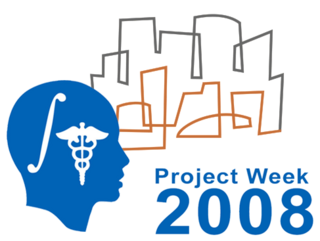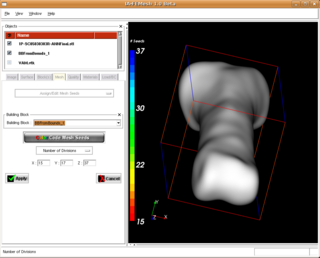|
|
| Line 7: |
Line 7: |
| | | | |
| | __NOTOC__ | | __NOTOC__ |
| − |
| |
| − | ===Instructions for Use of this Template===
| |
| − | #Please create a new wiki page with an appropriate title for your project using the convention NA-MIC/Projects/Theme-Name/Project-Name
| |
| − | #Copy the entire text of this page into the page created above
| |
| − | #Link the created page into the list of projects for the project event
| |
| − | #Delete this section from the created page
| |
| − | #Send an email to tkapur at bwh.harvard.edu if you are stuck
| |
| | | | |
| | ===Key Investigators=== | | ===Key Investigators=== |
| Line 58: |
Line 51: |
| | | | |
| | ===References=== | | ===References=== |
| − | * Fletcher, P.T., Tao, R., Jeong, W.-K., Whitaker, R.T., "A Volumetric Approach to Quantifying Region-to-Region White Matter Connectivity in Diffusion Tensor MRI," to appear Information Processing in Medical Imaging (IPMI) 2007. | + | * Grosland NM, Brown TD. A voxel-based formulation for contact finite element analysis. Comput Methods Biomech Biomed Engin. 5(1):21-32, 2002. |
| − | * Corouge, I., Fletcher, P.T., Joshi, S., Gilmore, J.H., and Gerig, G., "Fiber Tract-Oriented Statistics for Quantitative Diffusion Tensor MRI Analysis," Medical Image Analysis 10 (2006), 786--798.
| + | * Grosland NM, Bafna R, Magnotta VA. Automated Hexahedral Meshing of Anatomical structures using Deformable Registration. Computer Methods in Biomechanics and Biomedical Engineering. Accepted. |
| − | * Corouge, I., Fletcher, P.T., Joshi, S., Gilmore J.H., and Gerig, G., Fiber Tract-Oriented Statistics for Quantitative Diffusion Tensor MRI Analysis, Lecture Notes in Computer Science LNCS, James S. Duncan and Guido Gerig, editors, Springer Verlag, Vol. 3749, Oct. 2005, pp. 131 -- 138 | + | * Grosland NM, Shivanna KH, Magnotta VM, Kallemeyn NA, DeVries NA, Tadepalli SC. IA-FEMesh: An open-source, interactive, multiblock approach to musculoskeletal finite element model development. Submitted. |
| − | * C. Goodlett, I. Corouge, M. Jomier, and G. Gerig, A Quantitative DTI Fiber Tract Analysis Suite, The Insight Journal, vol. ISC/NAMIC/ MICCAI Workshop on Open-Source Software, 2005, Online publication: http://hdl.handle.net/1926/39 | + | |
| − | ===Text from Adam's Previous Page===
| + | |
| − | Back to [[NA-MIC_Collaborations|NA-MIC_Collaborations]], [[Algorithm:Site1|Site1 Algorithms]], [[DBP1:Site2|Site2 DBP 1]]
| + | |
| − | __NOTOC__
| |
| − | = '''Computing the Brain Deformation for Image-Guided Neurosurgery''' (The Intelligent Systems of Medicine Laboratory [http://www.mech.uwa.edu.au/ISML/ link title]
| |
| − | School of Mechanical Engineering, The University of Western Australia)=
| |
| | | | |
| | =Description= | | =Description= |
| Line 74: |
Line 64: |
| | | | |
| | | | |
| − | = Publications [http://www.ccad.uiowa.edu/mimx/publications/ link title]= | + | = [http://www.ccad.uiowa.edu/mimx/publications/ Publications]= |
| | | | |
| − | *[1] Miller, K., Joldes, G., Lance, D., Wittek, A. (2007) Total Lagrangian explicit dynamics finite element algorithm for computing soft tissue deformation, Communications in Numerical Methods in Engineering. Vol. 23, pp. 121-134, doi: 10.1002/cnm.887, available on-line at [http://www3.interscience.wiley.com/cgi-bin/jissue/109075715 link title].
| |
| − | *[2] Wittek, A., Miller, K., Kikinis, R., Warfield, S. K. (2007) Patient-specific model of brain deformation: Application to medical image registration. Journal of Biomechanics. Vol. 40, pp. 919-929, DOI:10.1016/j.jbiomech.2006.02.021, available on-line at [http://www.sciencedirect.com/ link title].
| |
| − | *[3] Joldes, G. R., Wittek, A., Miller, K. (2007) Suite of finite element algorithms for accurate computation of soft tissue deformation for surgical simulation, in Proceedings of Computational Biomechanics for Medicine Workshop, International Conference on Medical Image Computing and Computer-Assisted Intervention MICCAI 2007, Brisbane, Australia, ISBN 13: 978 0 643 09517 5, pp. 65-73.
| |
| − | *[4] Hawkins, T., Wittek, A. and Miller, K. (2006) Comparison of constitutive models of brain tissue for non-rigid image registration, in CD Proceedings of 2nd Workshop on Computer Assisted Diagnosis and Surgery, Santiago, Chile, 4 pages.
| |
| − | *[5] Horton, A., Wittek, A. and K. Miller (2006) Computer simulation of brain shift using an element free Galerkin method, in CD Proceedings of 7th International Symposium on Computer Methods in Biomechanics and Biomedical Engineering CMBBE 2006, Antibes, France, ISBN: 0-9549670-2-X, pp. 906-911.
| |
| − | *[6] Horton, A., Wittek, A. and K. Miller (2006) Towards meshless methods for surgery simulation. Linear versus non-linear computation of the brain shift, in Proceedings of Computational Biomechanics for Medicine Workshop, International Conference on Medical Image Computing and Computer-Assisted Intervention MICCAI 2006, Copenhagen, Denmark, ISBN 10: 87-7611-149-0, pp. 32-40 [http://www.mech.uwa.edu.au/ISML/publications.htm link title].
| |
| − | *[7] Joldes, G., Wittek, A. and Miller, K. (2006) Improved linear tetrahedral element for surgery simulation, in Proceedings of Computational Biomechanics for Medicine Workshop, International Conference on Medical Image Computing and Computer-Assisted Intervention MICCAI 2006, Copenhagen, Denmark, ISBN 10: 87-7611-149-0, pp. 52-63 [http://www.mech.uwa.edu.au/ISML/ publications.htm link title].
| |
| − | *[8] Joldes, G., Wittek, A. and Miller, K. (2006) Towards non-linear finite element, computations in real time, in CD Proceedings of 7th International Symposium on Computer Methods in Biomechanics and Biomedical Engineering CMBBE 2006, Antibes, France, ISBN: 0-9549670-2-X, pp. 894-899.
| |
| − | *[9] Miller, K., Joldes, G. and Wittek, A. (2006) New finite element algorithm for surgical simulation, in CD Proceedings of 2nd Workshop on Computer Assisted Diagnosis and Surgery, Santiago, Chile, 4 pages
| |
| − | *[10] Miller, K. Hawkins, T. and Wittek, A. (2006) Linear versus non-linear computation of the brain shift, in CD Proceedings of the 7th International Symposium on Computer Methods in Biomechanics and Biomedical Engineering CMBBE 2006, Antibes, France, ISBN: 0-9549670-2-X, pp. 888-893.
| |
| − | *[11] Miller, K. and Wittek, A. (2006) Neuroimage registration as displacement - zero traction problem of solid mechanics, Lead Lecture in Proceedings of Computational Biomechanics for Medicine Workshop, International Conference on Medical Image Computing and Computer-Assisted Intervention MICCAI 2006, Copenhagen, Denmark, ISBN 10: 87-7611-149-0, pp. 1-12 [http://www.mech.uwa.edu.au/ISML/ publications.htm link title].
| |
| − | *[12] Wittek, A., Kikinis, K., Warfield, S. K., and Miller, K. (2005) Brain shift computation using a fully nonlinear biomechanical model, in Proceedings of 8th International Conference on Medical Image Computing and Computer Assisted Intervention MICCAI 2005 in Lecture Notes in Computer Science 3750 2006, pp. 583-590.
| |
| | | | |
| | + | = Links = |
| | | | |
| − | ''In Press''
| + | * [http://www.ccad.uiowa.edu/mimx/ MIMX Group] |
| − | *[13] AWittek, A., T. Hawkins, and Miller, K. (2008). On the unimportance of constitutive models in computing brain deformation for image-guided surgery (in press). Biomechanics and Modeling in Mechanobiology: 8 pages, doi: 10.1007/s10237-008-0118-1, Springer. | |
| − | *[14] Grand Joldes, Karol Miller and Adam Wittek (2007) Efficient hourglass control implementation for an uniform strain hexahedra using Total Lagrangian formulation. Communications in Numerical Methods in Engineering (accepted in June 2007), 9 pages, doi: 10.1002/cnm.1034, Wiley.
| |
| − | | |
| − | = Links =
| |
| | | | |
| − | * Link1
| |
| − | * Link2
| |
| | | | |
| | Project Week Results: [[blah|Jan 2006]], [[blah|Jun 2007]] | | Project Week Results: [[blah|Jan 2006]], [[blah|Jun 2007]] |


